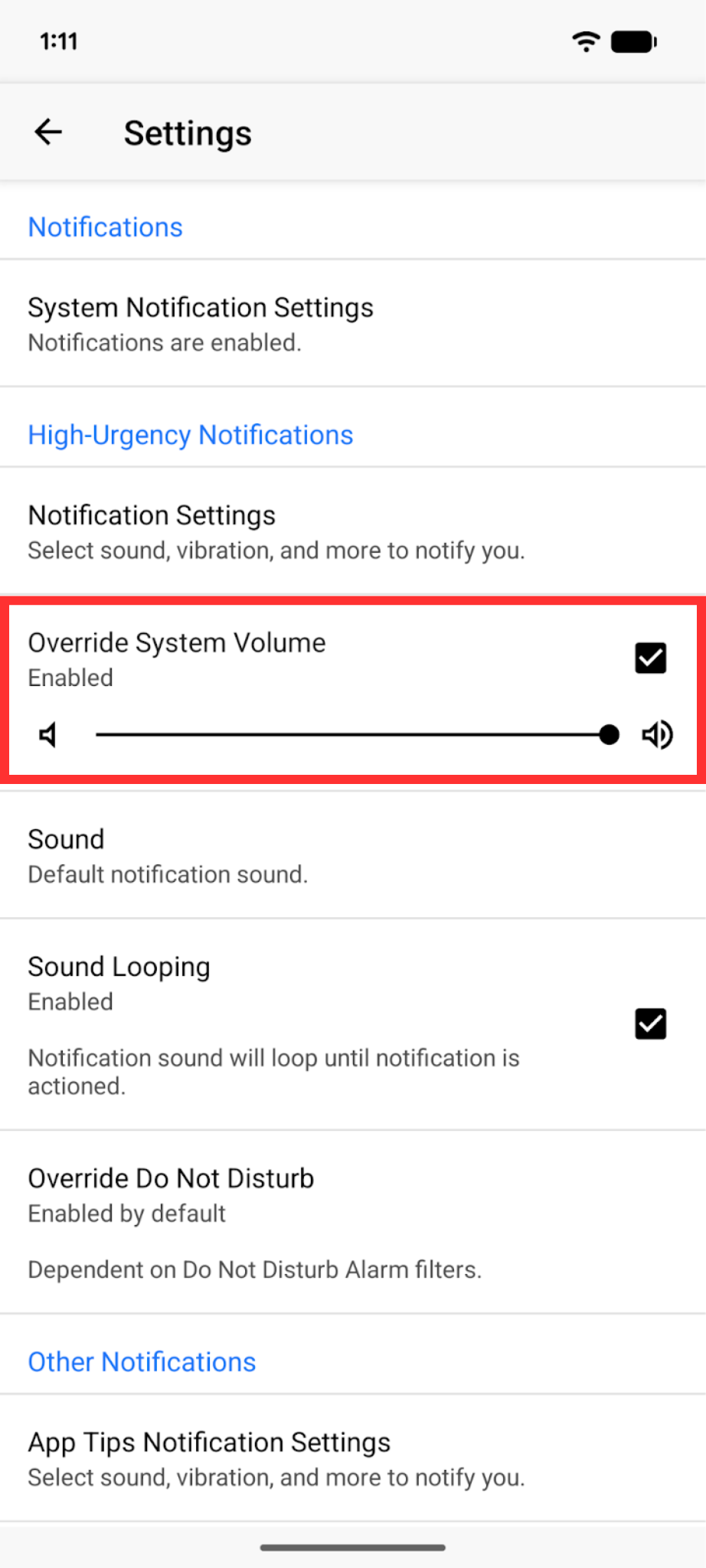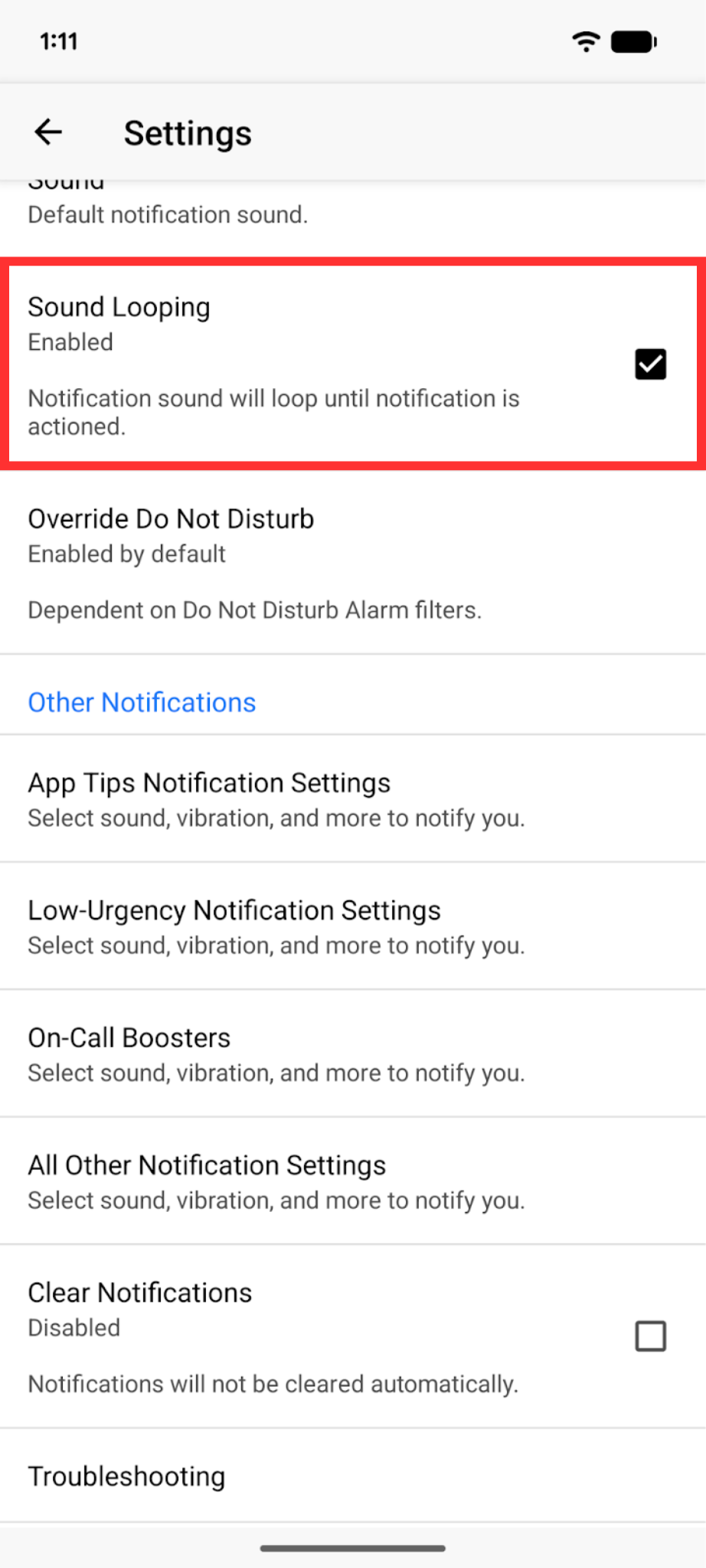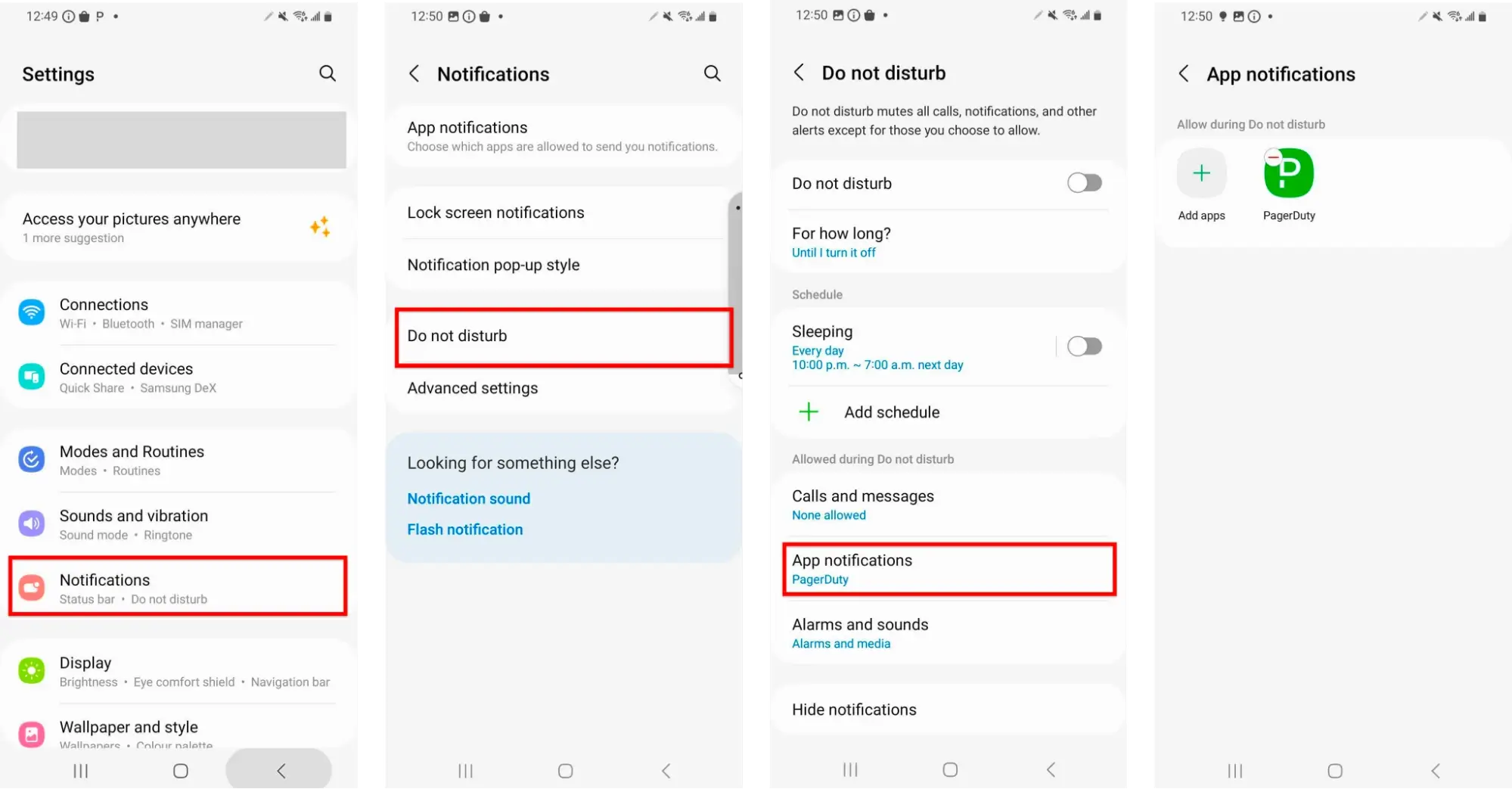Push Notification Troubleshooting
Troubleshoot issues with push notifications
Pre-Checks
Please complete the Notification Troubleshooting Pre-Checks before proceeding with this article.
Push notifications are the most reliable and robust method of notification delivery.
- 99.99% reliability backed by Apple and Google’s world class data centers
- Push notifications are not subject to local regulations that SMS and phone notification have
- Push notifications do not rely on aging and unreliable carrier networks for SMS and phone notifications
- Providers filter/drop SMS notifications based on the content in the SMS notification
- Data suggests 6x faster MTTA when responders have push notifications enabled
- We highly recommend push notifications as a 0-minute rule. For more information regarding best practices for setting up notification rules, please read the section Stagger Notification Rules.
General Troubleshooting
- Download the Most Recent Version of the Mobile App
- In-App Troubleshooting
- Enable Push Notifications in the Mobile App
- Perform a Reset
- Send a Test Notification in the Web App
- Check Push Notifications for Other Apps
- Check Firewall and Network Connection
- Check Blocked Devices on the User Profile Page
Download the Most Recent Version of the Mobile App
In some cases, there may be issues receiving push notifications if the mobile app version is out-of-date. You can download the most recent version of the PagerDuty mobile app from Google Play or the App Store. Please see our System Requirements for supported app versions and platforms.
In-App Troubleshooting
You can test notifications in the mobile app:
- Navigate to More Settings.
- Tap Troubleshoot Notifications.
Tests will automatically begin, with green check marks indicating success. If an issue is identified, an error message will suggest troubleshooting steps.
Enable Push Notifications in the Mobile App
In the mobile app, navigate to More Settings and verify that you have the following settings configured in the Notifications section:
- Confirm that Push Notifications have been enabled/toggled on (iOS).
- Under High-Urgency, select a sound that will play when you receive push notifications for high-urgency incidents.
- Optional: Under Low-Urgency, deactivate the Mute Sound toggle and select a sound that will play when you receive push notifications for low-urgency incidents.
Perform a Reset
In the PagerDuty app:
You may wish to reset your push notification settings and preferences.
- Remove the Account:
- On Android: Navigate to More , tap the menu to the right of the account, and tap Remove this account.
- On iOS: Navigate to More User Icon (top-left). Tap Edit, then tap next to the desired account. Tap Delete to confirm your selection.
- Force close the app.
- Open the app and log in to your PagerDuty account.
In the Settings app:
- You can also reset the app in your device’s settings app:
- On Android: Open the Settings app and navigate to Apps All Apps PagerDuty Storage & Cache, then select Clear Cache.
- On iOS: Open the Settings app, select PagerDuty, then turn the Reset toggle to the on position.
Send a Test Notification in the Web App
These steps outline how to send a test notification to the mobile app from the web app:
- Add your device as a contact method and add a notification rule for the device.
- Enable notifications for the PagerDuty app in your phone's Settings.
- Confirm you have the most recent version of the mobile app.
- In the web app, navigate to User Icon My Profile. With the Contact Information tab selected, click Test to the right of your device’s name.
Check Push Notifications for Other Apps
In rare circumstances, Apple may block specific devices from its Apple Push Notification Service. If you have any other apps that use push notifications, verify whether those apps are able to receive push notifications.
Also please check your Notification Center to see when you were last able to receive a push notification.
For Android, updating your phone may change the device ID. This can affect push notification delivery.
Check Firewall and Network Connection
You'll need an internet connection to register the PagerDuty app. If the device is connected to Wi-Fi (and no cellular connection is available), inbound and outbound TCP packets need to be sent over port 5223. Check to see whether a firewall is blocking these requests.
To work around a firewall that is blocking push notification registration, turn your device's Wi-Fi off, log out of the PagerDuty app, and log in again while using a cellular data connection. You can confirm that registration was successful in the web app on your user profile page; your device should appear in the Mobile App section.
Check Blocked Devices on the User Profile Page
If you uninstall and reinstall the PagerDuty mobile app, you may find multiple instances of the same device listed in the Mobile App section. Only one device can be registered at a time, and some entries may show Blocked next to them.
You can remove a Blocked device by clicking to the right of the device. This will also remove any notification rules associated with the device.
Other Common Issues
- Opt Out: This is a common reason, especially on iOS devices where apps must explicitly ask for permission to allow notifications.
- Do Not Disturb (DND): Certain notifications may be silenced when DND or Focus mode is enabled.
- Low App Usage: Some manufacturers will restrict notifications from infrequently used apps.
- Battery Optimization or Power Saving Mode: Aggressive battery optimization may limit background app activity, affecting notification delivery.
- Internet Connection: Service outages or degradation may impact the deliverability of push notifications.
- Limited Resources: Push notifications cannot be delivered if the device does not have enough resources to receive and store notifications.
- Outdated Operating System: Older operating systems might have compatibility issues with some notification systems.
Troubleshoot Push Notification Sounds
- Volume Muted or Low: The expected notification sound may not play if your device is silenced, or the volume is too low.
- Notification Sound Disabled: Check if you have sound enabled for PagerDuty app notifications.
- Competing Sounds: Other audio sources (e.g., loud music) can mask notification sounds.
- Headphones or Bluetooth Audio Connected: Audio may be directed to a different output than expected.
- Notification Tone: It can be hard to hear soft or non-distinctive notification sounds.
- Decibel Limits: Some devices include settings that limit the decibel of incoming notifications. This may cause unexpected behavior if there are any sound settings that would cause notification sounds to exceed the limit.
Android Device Troubleshooting
This guide covers common troubleshooting steps for notification issues specific to Android devices. Please see the section General Troubleshooting before using this guide.
- Enable Push Notifications
- Battery-Saving Mode
- Override System Volume
- Configure Override Do Not Disturb Manually
- Other Sound Issues
Enable Push Notifications
In order to receive push notifications on your Android device, Google Play Services must be enabled. If Google Play Services are enabled and the General Troubleshooting steps have not resolved the issue, you can try resetting the app.
To reset the app, navigate to Settings Apps All apps PagerDuty and tap Clear Storage.
Battery-Saving Mode
Some users have reported delayed notifications while using a battery-saving mode. You can adjust this setting for PagerDuty by going to Settings Battery Battery usage PagerDuty and selecting Unrestricted.
Other phones may have this setting labeled as Don't wake for notifications, which you can disable to prevent notification delays.
Override System Volume
Limitation
PagerDuty cannot override the volume for phone calls and SMS.
Recent versions* of our Android app offer a feature called Override System Volume. This feature is enabled by default but can be disabled by deselecting the checkbox.
**OnePlus devices on Android 10 and higher do not support Override System Volume for the PagerDuty app.

Sound
Notification Channel Settings
The sound in your device's High-Urgency Notification Channel settings must be set to "None". If a sound is set here, you will hear two notification sounds. The app will display a warning if this is detected.
If Override System Volume is enabled for High-Urgency Notifications, it will play as an Alarm sound by default. To change the sound, open Settings → Sound. Additionally, ensure that Settings → Notification Settings → Select Sound is set to None.
Sound Looping allows the notification sound to loop until the notification is actioned. If disabled, the notification sound will play once and the alarm volume will be reset after a short period of time.

Other Sound Issues
If you are receiving push notifications but are unable to hear a sound, please confirm the following:
- Android requires a sound to be selected for push notifications. Select a sound under Settings Sound & vibration Default notification sound.
- Check to see if any other volume-manipulating apps are running.
Manually Configure Override Do Not Disturb
Allow the PagerDuty Contact to Override Do Not Disturb
To have phone call and SMS notifications override Do Not Disturb, you will first need to allow the PagerDuty contact to override Do Not Disturb. Please see High-Urgency Override Do Not Disturb.
On some Android devices, the mobile app cannot automatically read from your Do Not Disturb (DND) settings. You can manually add PagerDuty to your DND settings, though:
- Navigate to your phone's Settings and select Notifications.
- Tap Do not disturb.
- Tap App notifications.
- Add the PagerDuty app to Allow during Do not disturb.

Manually configure override do not disturb
If you are using Android's Modes feature to enable Do Not Disturb, you must edit the Mode's settings to allow notifications from PagerDuty. Each Mode has its own Allow during Do not disturb list.
Apple Device Troubleshooting
This guide covers common troubleshooting steps for notification issues specific to Apple devices. Please see the section General Troubleshooting for initial troubleshooting steps.
- Enable Notifications
- Verify Your Device is Registered with PagerDuty
- Push Notification Doesn't Produce Sound
- Apple Watch Notification Troubleshooting
Enable Notifications
In iOS, it is possible to turn off notifications for individual apps. In the Settings app, tap Notifications and make sure the PagerDuty app is listed and enabled to play sounds and show Alerts or Banners. These are the app's default settings. If you don't see the PagerDuty app in Notifications, it is possible you didn’t allow PagerDuty to send push notifications when installing the app.
Apple suggests following these steps to enable notifications:
- Delete the PagerDuty app from your device.
- Turn off your device completely and turn it back on.
- Go to Settings General Date & Time and set the date ahead a day or more.
- Turn the device off completely again and turn it back on.
- Reinstall PagerDuty and tap Allow when prompted to allow push notifications.
Verify Your Device is Registered with PagerDuty
After logging in, PagerDuty registers your device's push notification token to our system. This allows us to send push notifications. In the PagerDuty web app, confirm that your device is listed on your user profile under Contact Information. If it is not in this section, or you see multiple devices, you'll need to allow notifications when opening the app for the first time. You may also delete and reinstall the app to re-register your device.
For more information, please read Log in to the Mobile App.
Push Notification Doesn't Produce Sound
If push notifications come through, but do not make a sound, in addition to checking sound settings, make sure that your device's Ring/Silent switch is set to Ring. If your device is on silent or vibrate, then PagerDuty notifications will also be on silent or vibrate.
Lastly, check that you are signed in to your Apple ID on your iOS device. Go to Settings Apple Account and enter your Apple ID and password.
Apple Watch Notification Troubleshooting
If there is an issue receiving notifications on your Apple Watch, make sure that you've logged in to the PagerDuty app on your iPhone. Then please check the following:
- Your Apple Watch must be on your wrist to receive notifications.
- Your iPhone must be locked to receive watch notifications.
- On your iPhone, notifications must be turned on for the PagerDuty app and the Apple Watch app.
- You can find this under Settings Notifications PagerDuty Allow Notifications.
Updated 13 days ago
